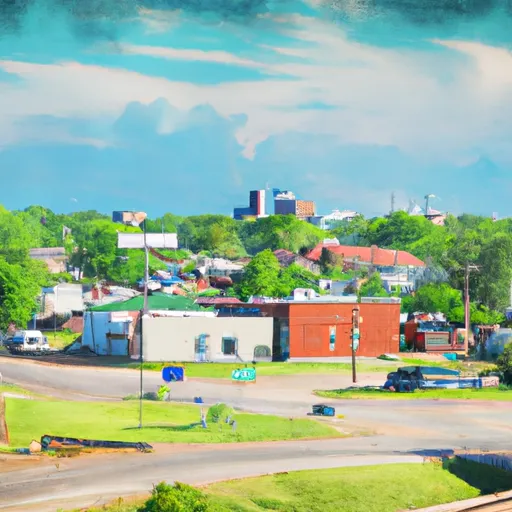-
 Snoflo Premium
Snoflo Premium
Get unlimited access to all our content
With no Ad interruptions! - Start Your Free Trial Login with existing account
Watson
Eden Index
Climate
7.7
•
Recreation
6.2
•
Community
•
Safeguard
5.2/10

Watson, Arkansas is a small town located in Desha County in the southeastern part of the state. The town experiences a humid subtropical climate, characterized by hot and humid summers and mild winters. Average temperatures range from the low 40s °F (5 °C) in winter to the high 90s °F (32 °C) in summer. Precipitation is evenly distributed throughout the year, with an average of 50 inches (127 cm) annually.
Hydrologically, Watson is situated near the Mississippi River, offering access to various water activities. The river is a popular spot for fishing, boating, and water sports enthusiasts. Additionally, Watson is surrounded by numerous lakes and reservoirs, such as Lake Chicot and the Arkansas River, providing additional opportunities for outdoor recreation.
Outdoor enthusiasts can enjoy activities such as hiking, camping, and birdwatching in the nearby Delta Heritage Trail State Park. The park offers scenic trails through the beautiful Mississippi River Delta region, showcasing the area's unique flora and fauna.
In conclusion, Watson, Arkansas offers a humid subtropical climate, access to the Mississippi River, and various outdoor recreation opportunities including fishing, boating, hiking, and birdwatching.
What is the Eden Index?
The Snoflo Eden Index serves as a comprehensive rating system for regions, evaluating their desirability through a holistic assessment of climate health, outdoor recreation opportunities, and natural disaster risk, acknowledging the profound impact of these factors on livability and well-being.
Climate Health Indicator (CHI): 7.7
Watson receives approximately
1284mm of rain per year,
with humidity levels near 90%
and air temperatures averaging around
17°C.
Watson has a plant hardyness factor of
8, meaning
plants and agriculture in this region tend to thrive here all year round.
By considering the ideal temperature range, reliable water supplies, clean air, and stable seasonal rain or snowpacks, the Climate Health Indicator (CHI) underscores the significance of a healthy climate as the foundation for quality living.
A healthy climate is paramount for ensuring a high quality of life and livability in a region, fostering both physical well-being and environmental harmony. This can be characterized by ideal temperatures, reliable access to water supplies, clean air, and consistent seasonal rain or snowpacks.
Weather Forecast
Streamflow Conditions
Boeuf-Tensas
Area Rivers
Boeuf-Tensas
Snowpack Depths
Boeuf-Tensas
Reservoir Storage Capacity
Boeuf-Tensas
Groundwater Levels
Recreational Opportunity Index (ROI): 6.2
The Recreational Opportunity Index (ROI) recognizes the value of outdoor recreational options, such as parks, hiking trails, camping sites, and fishing spots, while acknowledging that climate plays a pivotal role in ensuring the comfort and consistency of these experiences.
Access to outdoor recreational opportunities, encompassing activities such as parks, hiking, camping, and fishing, is crucial for overall well-being, and the climate plays a pivotal role in enabling and enhancing these experiences, ensuring that individuals can engage in nature-based activities comfortably and consistently.
Camping Areas
| Campground | Campsites | Reservations | Toilets | Showers | Elevation |
|---|---|---|---|---|---|
| Oak Grove City Park | 30 | 117 ft | |||
| Chicot County RV Park | 98 | 111 ft | |||
| Farr Park | 108 | 26 ft | |||
| Kemper Williams Parish Park | None | 5 ft | |||
| Lake End City Park | 74 | 4 ft | |||
| Lake Bruin State Park | None | 75 ft | |||
| Grand Gulf Military Park | 42 | 238 ft | |||
| Lake End Park | 167 | 4 ft | |||
| Natchez State Park | None | 236 ft | |||
| Warfield Point Park | None | 132 ft |
Nearby Ski Areas
Catastrophe Safeguard Index (CSI):
The Catastrophe Safeguard Index (CSI) recognizes that natural disaster risk, encompassing floods, fires, hurricanes, and tornadoes, can drastically affect safety and the overall appeal of an area.
The level of natural disaster risk in a region significantly affects safety and the overall livability, with climate change amplifying these risks by potentially increasing the frequency and intensity of events like floods, fires, hurricanes, and tornadoes, thereby posing substantial challenges to community resilience and well-being.
Community Resilience Indicator (CRI):
The Community Resilience Indicator (CRI) recognizes that education, healthcare, and socioeconomics are crucial to the well-being of a region. The CRI acknowledges the profound impact of these elements on residents' overall quality of life. By evaluating educational resources, healthcare accessibility, and economic inclusivity, the index captures the essential aspects that contribute to a thriving community, fostering resident satisfaction, equity, and social cohesion.

